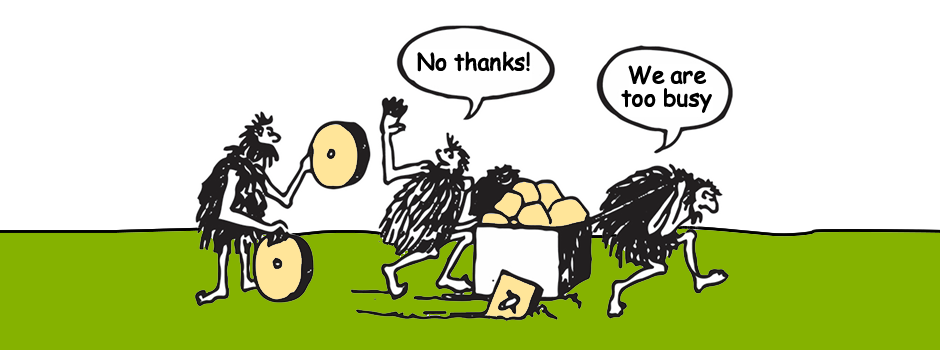Their Father (Grug), hates change and enforces his survival mantra “Never not be afraid!” to keep his family safe. Eep’s curiosity overrides her fear, and when a natural disaster destroys their cave, the family is forced into an adventure that leads to a beautiful new world. They discover that enemies can be friends and that innovation and teamwork ensure survival. Perhaps you feel like Grug – stuck in a cave out of deep concern for the survival of your business and the livelihood of your family and employees. You sense that change is needed, but a large risky venture could end up being a failed experiment with devastating consequences.

Our world is changing. We feel the impact on our businesses daily with industry changes and other external factors. Customer behavior is also changing and the buying decisions in many organizations have become an obstacle course of red tape and complexity. We march to a new beat, it’s off-beat and we’re struggling to find our footing. To survive, we need to find a different route and learn to embrace change as we step into the unknown.
The dictionary defines a “step change” in business, as “a significant change that results in an improvement or increase”. The key here is that a step change does not have to be BIG, but it needs to be SIGNIFICANT. It is often the small things that make a big difference. Small innovations in your day-to-day operations that lead to an agile business with delighted customers.
The thing about small things, is that they are often difficult to see. You have to look for them and be intentional about it. Allow yourself to be curious and to ask “Why?” to get to the significant answer. Get input from others, not only to understand problems and constraints, but to come up with solutions too. The setting doesn’t have to be formal either. A cup of coffee with a key stakeholder may lead to some surprising insights.
So, if it’s that simple, why aren’t more people doing it? Here are some of the obstacles to change that I’ve observed.
1. Not being clear on Why you do what you do. Have you ever tried building a thousand-piece puzzle without the picture? You kind of wish your aunt’s basset hound ate all the pieces instead of just chewing up the box. The point is, you need a clear picture that is easy to communicate. A vision clearly points to the direction you want people to move in. It answers the “Why?” for everyone involved. You can have a thousand detailed plans, but if you don’t know why you’re exerting the effort and making the sacrifices, you won’t be able to lead others on the journey.
The Vision needs to be communicated as frequently as possible. Refer to it during discussions about customer needs or operational challenges. Show people how the solutions tie back to the big picture. Make sure that there is a clear path in the story from the vision to employee scorecards and deliverables.
2. The plan seems too daunting so, I find myself procrastinating. There’s nothing that kills off momentum like overly ambitious, grandiose or complex plans. Leonardo da Vinci said, “Simplicity is the ultimate sophistication” and it still holds true today. As much as people need to know where they’re heading, they need to be clear on the bite size pieces that will help them get there. The short-term milestones keep us motivated. Quick wins not only drive momentum, but also create buy-in from more stakeholders to support the vision.
3. Being in denial about the need to change. Sometimes we wait for the cave to collapse before we make the necessary changes. It may seem easier to believe that you have more time to change course than you do. Perhaps you’re turning a blind eye to the cost of inefficiency in your business. If you consider the compounded benefits of adjusting sooner rather than later, it will motivate you to make the tough calls.
Challenge yourself to take the small steps that will lead to big changes. To be a curious forerunner in problem solving and acknowledging the tell-tale signs that it’s time for change. In a roundabout way it is often the stone in our shoe that creates opportunities that we wouldn’t have considered otherwise. You can implement small, continuous improvements while you’re providing the necessary leadership and direction to safely navigate through change. Those small incremental steps towards the vision will create a brave new momentum for you and your business.
What small steps are you taking towards your vision this week?







